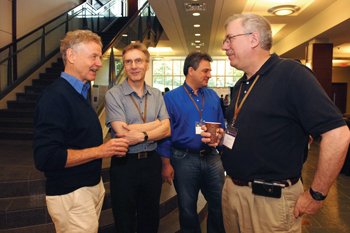
MIT’s Rudolf Jaenisch, M.D., left, talks with Vanderbilt’s Christopher Wright, D.Phil., Ronald Emeson, Ph.D., and Mark Magnuson, M.D., at last week’s mouse genomic engineering conference. (photo by Anne Rayner)
Conference outlines advances in mouse genomic engineering
Scientists from around the world came to Vanderbilt University last week to discuss recent advances in mouse genomic engineering and share tools for generating new mouse models of disease.
One of the pioneers of the field, Rudolf Jaenisch, M.D., led off the conference, entitled “Building a Better Mouse,” with his keynote address on July 12.
Jaenisch, a professor of Biology and founding member of the Whitehead Institute for Biomedical Research at Massachusetts Institute of Technology (MIT), is well-known for creating the first transgenic animals.
More recently, Jaenisch has been recognized as a leader in the field of therapeutic cloning, in which DNA from one cell is transplanted into an unfertilized egg to create a source of embryonic stem cells for further research and, potentially, to treat disease.
About 200 participants from a dozen countries attended the conference, hosted by the Vanderbilt Center for Stem Cell Biology and the Program in Developmental Biology.
The conference was organized by Mark Magnuson, M.D., who directs the Center for Stem Cell Biology; Christopher Wright, D.Phil., director of the Program in Developmental Biology; Ronald Emeson, Ph.D., deputy director of the Center for Molecular Neuroscience; and Maureen Gannon, Ph.D., assistant professor of Medicine and Molecular Physiology & Biophysics.
Although therapeutic cloning — also called nuclear transfer — has shown promise in generating “customized tissues” for use in treating human diseases, the field is fraught with moral, ethical and technical controversy due to the involvement of human embryos.
Acknowledging these challenges, Jaenisch discussed recent advances from his lab and others involving a much less ethically contentious alternative to nuclear transfer techniques: the “reprogramming” of adult cell nuclei.
By activating a few key developmental genes that in turn regulate the expression of numerous other genes, the researchers made adult skin cells undergo an amazing reversion, turning back their internal clocks and adopting an embryo-like genetic state. These cells continued to propagate in vitro, and were shown to acquire the remarkable ability to contribute properly to all of the tissues in live-born mice.
This ability to reactivate an embryonic-like “epigenetic” state may offer an important new approach to stem cell research aimed at generating human tissues in large quantities for transplant, he said.
Although recent successes indicate quantum leaps in this respect, finding the right way to direct the formation of the desired cell types from stem cells in large quantities in culture is difficult, noted Gordon Keller, Ph.D., director of the McEwen Centre for Regenerative Medicine in Toronto.
Small numbers of stem cells may help keep adult organs functioning normally, whether it is the kidney, pancreas or the heart, and it is possible that, once identified, such cells could be signaled to undertake tissue repair as and when needed. Achieving full organ-specific functionality “is the challenge of the next few years,” Keller said.
Other speakers included Allan Bradley, Ph.D., director of the Wellcome Trust Sanger Institute in Cambridge, England; Janet Rossant, Ph.D., senior scientist at the Hospital for Sick Children in Toronto, who gave the second keynote address; and Guoqiang Gu, Ph.D., assistant professor of Cell & Developmental Biology at Vanderbilt.
This was Vanderbilt's second highly successful “Building a Better Mouse” conference. The first was held in 2004.













